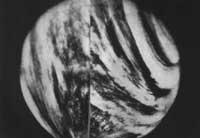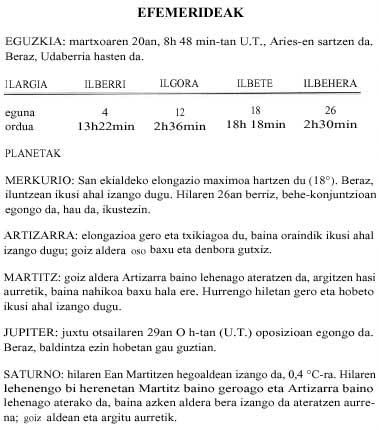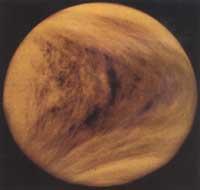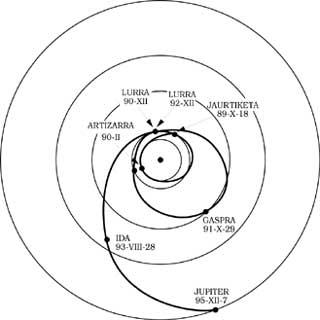The atmosphere of Venus
1992/03/01 Arregi Bengoa, Jesus Iturria: Elhuyar aldizkaria
It is well known that the atmosphere of Venus hinders the vision of this planet. The continuous cloud layer of the atmosphere does not allow to see the overload. The opacity of the layer, however, does not lie in the size of the fractions that form it or in the density of the clouds, but in its width, since it extends to a height between 50 and 75 km.
Above these clouds, in another 30 kilometers, we have another layer of much lower density, which we could compare with the terrestrial mist. Therefore, as for the optical consistency of this upper layer, we can say that it is much weaker than that of clouds, reaching only a hundred of them.
The albedo of the clouds is very high, very similar to that of the snow. The lack of configuration or stable structure shows us that reflected light is what we see from Earth, without receiving any superficial information. Therefore, the speed of rotation of Venus has not been reliably measured until recently, when the first studies with radars were carried out. According to the results of these measures, the turning period is 243 days and the movement is backward.

The backward movement may be associated with Venus having no satellites (it may not have ever had them, but it must be noted that Earth and Mars are similar to it). Let us remember, before moving forward, what happens in a system like the Earth and the Moon. Due to the tidal effects that the bodies interact, the spinning speed decreases and this loss of angular momentum is compensated by increasing the distance between them.
Let us now think that at one time Venus and its possible satellite formed a system similar to that of the Earth and the Moon, but with the trajectory of the satellite more eccentric than that of the Moon. The braking of the described turn would paralyze Venus turning the movement back. Therefore, the satellite would move further away from its influence. If, on the contrary, we recognize that the reverse turn of Venus is caused by the tidal effect of the Sun or other external agent, the tidal effect of the planet would cause the satellite to fall.
However, let us put aside the inconvenience of the clouds of Venus for us and analyze what their interest is. Clouds reflect almost eighty percent of the emission coming from the Sun (especially at the wavelengths of yellow and red). Therefore, Venus is closer and receives less solar energy than the Earth. Two thirds of this energy that, reflected, does not return to space, is absorbed by the clouds themselves in the fields of ultraviolet and near-infrared.
Therefore, the other third (about fifteen of the total energy) reaches the surface, creating a dark orange environment. However, the surface temperature is 450ºC in the luminous hemisphere and 300ºC in the gloom. These high temperature values are a consequence of the composition of the atmosphere that we will analyze immediately.
We can say that the atmosphere of Venus hardly contains oxygen. In contrast, the proportion of carbon oxide IV, C02, is 96.5%. and almost all the rest is mole cular nitrogen, N2. Very small proportions must be reserved for other components such as 0.1 or 0.2% for water vapor.
As can be seen, the main atmospheric component is carbon dioxide, which causes the most known greenhouse effect in recent years. This effect is the cause of the peculiarities of the atmosphere of Venus. The incident radiation warms the surface of Venus and its infrared emission cannot leave the atmosphere. Therefore, although the amount of energy that reaches the surface of Venus is less than that which reaches the Earth, the temperature is much higher.
For the same reason the difference between light and dark is no greater. Like the Moon and Mercury, stars with a very fine atmosphere lose heat quickly and the commented difference is usually very large. However, we should not think that this is a loss of heat from the planet. The high layers of the atmosphere are constantly losing heat and the temperature at the top of the clouds is about -30ºC. Technical maps indicate that the emission difference between light and dark differences is as small as that between low and high latitude regions.
Based on this detail, it can be concluded that the duration of the day of Venus is not enough for the low layers of the atmosphere to cool and that there is a significant horizontal circulation of heat. These situations generate a special atmospheric dynamic. As they are the warmest in the equatorial regions, convective currents are generated that move upwards. At the top they migrate to the poles to descend to the surface. From there the current turns to the equator to fill the gap that leaves the local gas when climbing. Logically, symmetric movements occur in both hemispheres.
So far, besides mentioning the cloud layer, we have done little. Let's give some interesting details about it. The main component of clouds is sulfuric acid, which makes up three quarters of its mass. There are two main reasons that lead us to this conclusion. The first is that the reflection spectrum is similar to that of sulfuric acid. The second, the analysis of the polarization of reflected light indicates that the fractions that form the clouds are spherical. Liquid drops therefore have a refractive index of 1.44. This result excludes virtually all possible components except sulfuric acid.
Water too, because its index is 1.33. The basic gases that make up sulfuric acid in Venus are sulfur dioxide (S02), hydrogen sulfide (SH2), dimethyl sulfide (CH3)2S) and carbonyl sulfide (OCS). They do not account for 0.02% of the atmosphere. Clouds, on the other hand, do not exceed 0.00002%. However, we have seen how much they influence. Bear in mind that the atmosphere of Venus is about 90 times denser than that of the Earth, while the pressure multiplies equally (about 95 bars).
In general, it is considered a surprising detail the presence of clouds of sulfuric acid, although not so rare. In the earth itself this compound appears very diluted in acid rain. In addition, it appears with a density similar to that of Venus in the so-called Junge layer in the stratosphere.


Gai honi buruzko eduki gehiago
Elhuyarrek garatutako teknologia






